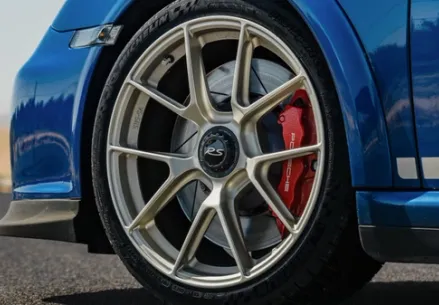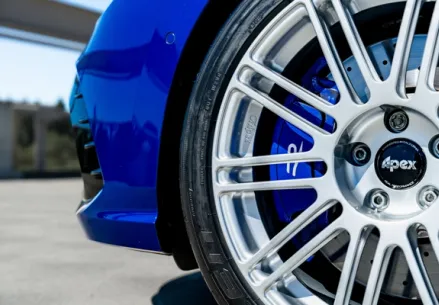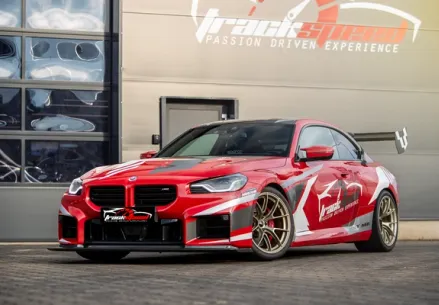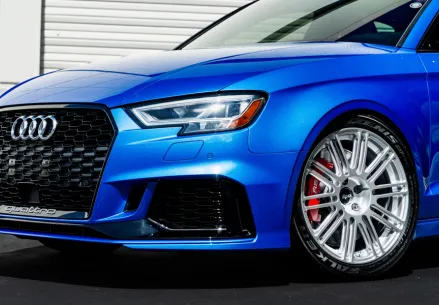
The Best 1 Series Track Wheels?
Article | 09/13/2013 by Ryan March
Updated on 08/06/2024
Article updated on: 2/16/2023
NOTE: Since this article was first written, we have developed a more aggressive track fitment for the 1 Series using 17x9” ARC-8 wheels. The 17” wheels are lighter than the 18s featured below, plus running 17” tires can help reduce the cost of consumables.
If you’re looking for recommendations for the 1M, read our 1M Wheel & Tire Fitment Guide.
WHY A 1 SERIES ISN’T AN EASY FIT FOR WIDE WHEELS AND TIRES
The E8x 1 Series has always been a BMW that cries for more grip. With a better power-to-weight ratio and a smaller size than the 3 Series, its narrow and staggered run-flat tire and wheel package doesn’t come close to taking advantage of the car’s true potential. If your 135i or 128i sees track or autocross time, or you just want it to handle better, wider tires on wheels designed specifically for the 1 Series will make a huge difference in its handling. Get the grip to take full advantage of the 1 Series’ potential and any power modifications you may have.
Sadly, there are few off-the-shelf options for wheel/tire packages, as the fitment specifications are very different from the common 3 Series. A wide, meaty tire on a wheel with 3 Series offsets will stick out of the fender on a 1 Series. Stretched tires that are too narrow, aggressively rolled and flared fenders, or running excessive amounts of negative camber are some of the steps owners take to shoehorn wheels onto a 1 Series.
APEX developed a better alternative. Our 1 Series-specific wheels, EC-7 and ARC-8, have specifications that allow for the maximum amount of wheel and tire width, with little or no modification. There is no better way to properly fit a 255, 265, or even a 275 tire onto your 1 Series than with APEX, 1 Series-specific wheels.
OUR 1 SERIES TEST CAR WITH ARC-8 WHEELS: 18X8.5″ ET45 FRONT, 18×9.5″ ET58 REAR
This 135i with ARC-8 wheels is using our 1 Series-specific fitment with 18X8.5″ ET45 front and 18×9.5″ ET58 rear wheels. This is a very flexible setup that, depending on your car’s suspension setup, accommodates a 225-255 tire in front and a 245-275 in the rear. Our test 135i is a serious track car that uses Hoosier R6 track tires in 245/35/18 front and 255/35/18 rear sizes. In combination with coilovers and camber plates, this car is running r-compounds that are as wide as most 255 front and 275 rear street tires.
Fitment Gallery
AN AMAZING BUILD AND A SECOND SET OF ARC-8 WHEELS
Our test car is a phenomenal example of a very clever enthusiast modifying their car to be perfect on the street and the track. This article profiles their track fitment and tires but we wanted you to know they have a second set of ARC-8 wheels with Yokohama S-Drive tires for their street setup: 18X8.5″ ET45 with 225/40/18 front, and 18X9.5 ET58 with 255/30/18 rear.
The owner built some of their own parts and even constructed tools to install them. With modifications to improve overall airflow, cooling, and a tune, this 135’s weak points have been cured and its strong points enhanced. Along with the Evolution Racewerks power mods, Ground Control suspension, StopTech BBK, Borla Exhaust, and APEX ARC-8 wheels, the owner built the oil cooler and some of the tools that allowed him to install a full M3 suspension. This 135i is the perfect combination of street-tuned and track-specific. The attention to detail in the build and “finished” result created quite a stir in the office. If you have a 135i, this is a setup to take note of.
SPECIFICATIONS
- Car/chassis: 2009 BMW 135i
- Wheel model: ARC-8, Satin Black, 18×8.5″ ET45 Front and 18×9.5″ ET58 Rear
- Tires: Hoosier R6’s – 245/35/18 front and 255/35/18 rear.
Suspension
- Ground Control Coilovers
- Ground Control Race Camber Plates
- Ground Control Toe Links
- Camber and Alignment:
- Front: -3.2* degrees with -0.8 toe
- Rear: -2.2 degrees with -0.4 toe
- Ride Height: 25.5″ front and rear
- Spacers: 5mm front (3mm is enough)
- Fenders and body modifications: front fenders are rolled**
- Brakes:
- Front – StopTech 355mm ST60
- Rear – BMW Performance Single Piston
- Clearance
- Front: Rim/Tire – Strut; 4mm, Tire – Fender; 0mm w/o fender roll, 2mm w/ minor fender roll.
- Rear: Rim/Tire – Strut; 10mm, Tire – Fender; 0mm w/o fender roll, 2mm w/ minor fender roll.
* -3.2 degrees of front camber can be achieved through the use of camber plates. This allows wider tires to fit in the front by tilting the wheel and suspension in at the top.
** Rolling fenders means to flatten the inner fender lip against the outer fender. Doing this creates, approximately, an additional 5mm of outer clearance although this is not true on all BMWs.
Contact us. We will help create a wheel/tire package specifically for your 1 Series and how you use it. You can see all the options for your 1 Series track wheels in our 1 Series Wheel & Tire Fitment Guide.
DETAILS: WHEELS, TIRES, SUSPENSION, CAMBER PLATES, SPACER, BRAKES
WHEELS — 18X8.5″ ET45 FRONT, 18×9.5″ ET58 REAR
Like other wheel manufacturers, we originally only had a 3 Series front wheel fitment available (18×8.5″ ET38) for 1 Series owners. We quickly found this to be too much of a compromise. Directly bolted onto the 1 Series, this wheel with a 235/40/18 tire would just slightly stick out of the front fender and rub. It stuck out even worse in the rear, a half an inch more than the stock wheel. It was necessary to create a 1 Series-specific fitment if we were going to fit wheels/tires wide enough to maximize the car’s potential.
The new front wheel, with a 45mm offset pulls it in an additional 7mm, which eliminates the front fender-side rub the 3 Series wheel had with the 38mm offset. The only trade off is that the wheel and tire are 7mm closer to the front suspension. Because of this, selecting the right aftermarket suspension that doesn’t waste space is important. With a number of suspension solutions that work, fitting much wider front tires on your 1 Series is possible. Coilovers are not necessary, with camber plates, stock struts and even springs can work, and in most cases they offer the most clearance.
In the rear we wanted to increase wheel width significantly. In 2009 we worked with BERK Technology, who were running a very competitive Red Line Time Attack 135i. Our testing with them led us to produce a 9.5″ wide wheel with a very unique BMW offset, 58mm. This allowed them and other 1 Series owners/racers to run a 275 tire in aggressive applications, while at the same time allowing a 265/35/18 to directly fit onto a 100% stock 1 Series. The key to this offset is keeping the tire deeper in the fender. Any lower of an offset would result in pushing the tire out, and under compression a wide tire would hit the fender. Without our unique offset, tires as narrow as 245 (the stock size) can be difficult to fit onto a wheel of the same width.
A SQUARE SETUP
On BMWs, square*** setups are typically ideal for track and Autocross use. Unfortunately, due to the unusual offsets on the 1 Series, square setups require significant fender rolling or flaring with rubbing being accepted to even fit a 245/35/18 tire. Although it is possible to run the 18×8.5″ ET45 wheel front and rear, this fitment will usually limit the maximum usable tire size on the rear to no wider than the stock 245/35/18 size, and in many cases only a 235/40/18 all around.
A 9.5″ ET58 rear wheel actually fits much easier than an 8.5″ ET45. With this recommended staggered setup you gain a significant amount of rear grip that can handle the horsepower and torque of a modified 1 Series, and it fits cleaner.
The only recommended option for a square setup with 9.5″ wheels is to do what some APEX customers have already done. Install the Evolution Racewerks front widebody kit and use the 18X9.5″ ET58 rear fitment but with the widebody you can now use the 18X9.5″ ET22 in front.
*** Same wheel and tire size front and back.
TIRES
Whether you plan to run R-Compounds or street tires, you can choose the same exact sized tires, or slightly narrower, with confidence knowing this wide setup fits with the supporting modifications and alignment specs listed above.
On our test vehicle, the front wheels use a 5mm spacer to allow the 245/35/18 Hoosier to clear the AST coilovers. Our testing shows that in most cases only a 3mm spacer is needed to clear the stock strut tube and certain aftermarket suspension. Even with a 5mm spacer, the wheel is a far more ideal offset than the 8.5″ ET38 version of the wheel. Narrower sizes such as 235 tires usually require no spacer. Again, this depends on the type of tire and the suspension used.
There are only a few tires size combinations that work properly on the 1 Series. 225/40/18 235/40/18, 245/35/18, and 255/35/18 are sizes that can work up front, but some sizes will require specific modifications to fit such as camber plates, spacers, and/or trimming of the fender liner. Almost every tire make/model is slightly different in shape, with some being significantly narrower, or wider for other tires of the same labeled size. It is recommended that you consult with us regarding tire sizes due to all the fitment variables that need to be considered.
A common mistake is purchasing tires in widths that are known to work, but not paying attention to the overall diameter or aspect ratio. A 245/35/18 is an extremely ideal tire size for the front of the 1 Series as it’s a wide tire that is very close to the overall diameter of the stock front tire size. We have seen many 1 Series owners mistakenly purchase 245/40/18 tires which are approximately 1 inch taller. This results in all sorts of issues, such as touching the inner fender liner while turning, contacting the suspension, and touching the fender.
Rear tires sizes should be limited to 255/35/18 and 265/35/18 street or extreme summer tires for the easiest, most direct fitment. 275/35/18 tires can work in the rear in both street and r-compound sizes, but there are some variables that can cause misfitment. It is recommended that you consult with us for all 275 tire fitments, and any r-compound fitments of 255 or wider in the rear.
SUSPENSION & CAMBER PLATES
The Ground Control (GC) coilovers paired with the GC camber plates are a large part of what makes this car so versatile. With coilovers that create maximum clearance and adjustable camber plates, this car has fitment-specific camber settings that can be easily adjusted at home or the track when switching between track and street setups.
The owner of this car actually runs a different set of APEX wheels with narrower tire sizes for the street. At the track, he can easily adjust his camber plates to properly fit the wider Hoosier tire, and optimize grip in the corners. Once the track day is over, adjusting the front camber back to stock for ideal tire wear on the street is easy.
CAMBER PLATES
Adding negative camber with camber plates is almost always recommended to customers looking to run a wide, meaty tire in the front of a BMW. Without them, 245-section tires will not fit on the front of a 1 Series. They are a must for proper fitment of wide front tires. In addition to added cornering grip, the adjustable plates allow your alignment to change to a more negative camber setting. Doing this pulls the top of the suspension in towards the engine bay. The entire suspension, wheel, tire, and brake assembly move in parallel to each other, so inner clearances stay the same, while the tire is pulled away from the outer fender. In the above photos you can see that even with these wide tire sizes, the wheel and tire can easily clear the fender both front and back even during hard cornering with a lot of compression. It’s key that a fitment does not rub under compression for it to work well on the track and street.
For this 135’s track fitment, -3.2 degrees of front camber is necessary to comfortably clear the fender in a high-compression turn. Street tire fitments with 245 and in some cases 255 tires usually only require -1.5 to -2 degrees camber to clear the strut.
SUSPENSION
Suspension dimensions can be particular to each brand and model. Wider or narrower strut bodies, longer or shorter springs, and progressive (conical) or linear (straight wound) springs are all considerations when choosing aftermarket suspension. These elements along with ride height all play a part in creating or eliminating clearance between the wheel and strut tube. The Ground Control coilovers on this test car use shorter, 6″ linear springs, narrow diameter strut tubes, and lower spring perches that sit above the tire. All of these dimensions help to create the necessary inner clearance to fit maximum-width tires.
Below you can see that these coilovers have a lower spring perch that sits just above the widest part of the tire/rim, allowing for the most possible inner (strut) clearance. Ground Control did a great job with the design of their lower spring perch by actually removing material from the part of the perch that faces the tire. This material removal allows for even more clearance vs. many other coilovers on the market.
We are familiar with what suspensions do and do not work, in addition to understanding how to configure aftermarket suspensions to avoid fitment issues. Contact us if you have aftermarket suspension, or are considering it. We can recommend companies who offer kits that will work with this fitment and tires you use or will be using.
SPACERS
The owner of this car used 5mm spacers in the front to add a little more strut clearance as needed with the 245 Hoosiers. Without them there would have only been 2mm of inner clearance, and that could have touched under cornering. Because the camber plates create a lot of fender side room, there is no problem using spacers to push the wheel out from the strut with 3 or 5mm spacers.
If you are trying to fit an extra wide tire in the front of a 1 Series, small spacers are a great way to fine-tune your fitment and achieve the perfect inner and outer clearance, and may be required in many situations.
NOTE: We’ve recently discovered through the feedback of 2 customers that in a very rare case (1 in 100), the ET45 wheel can touch the strut tube up front even with a conservative tire mounted. Using 3mm or 5mm spacers resolved the issue, and the cars could still fit street tires without any other mods. We are researching what models may be affected, although the workaround is simple.
BRAKES
The StopTech 355mm Big Brake Kit with 6 piston ST60 calipers fits with ease behind both the ARC-8 and EC-7 wheels. We measured 18mm of clearance to the barrel and over 20mm to the spokes. Needless to say, clearance for an OEM front brake isn’t a concern at all. As expected the rear BMW Performance brakes have no clearance issues as they are noticeably smaller.
With so much clearance to the rim and spokes of the ARC-8’s, the OE Brembo 355’s and AP Racing 355’s won’t have a problem clearing this setup. Any 355mm or even 365mm kit will fit with ease.
SUMMARIZE
This wide, staggered, fitment is the perfect example of a track setup done right, and it’s easy to replicate. The key is not to compromise:
- Make sure you select true, 1 Series-specific wheels.
- Choose a tire size that is ideal, balancing aesthetics, performance, and clearance.
- If you install aftermarket suspension, choose one that doesn’t get in the way and waste valuable tire space.
- Install camber plates to increase your negative camber for added grip and clearance.
- Last but not least, throw some sticky tires on there.
We’re experts on this fitment. Please contact us with any questions you have and guidance you may need.
Tags
 Ryan March
Ryan MarchIf you like cheap gear you will hate this newsletter.















